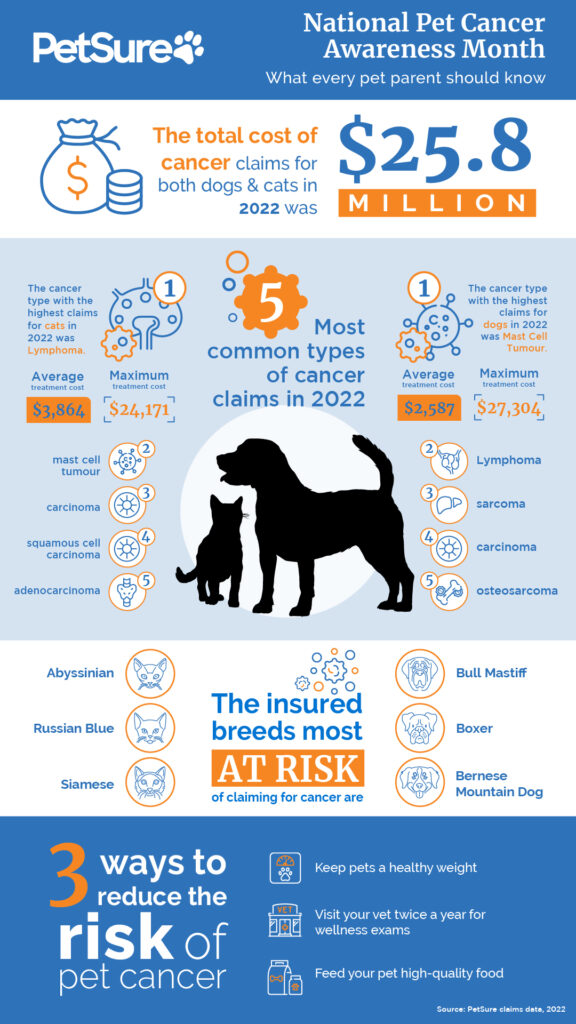Cancer or neoplasia refers to an uncontrolled growth of abnormal cells. Just like humans, our pets can be affected by cancer, according to the American Veterinary Medical Association 1 in 4 dogs will develop cancer during their lives¹ and 45% of dogs living to 10 years or older are expected to pass away due to cancer².
As diagnosis and treatments improve, more pet parents and veterinarians are choosing to treat cancer in pet patients. According to PetSure claims data in 2022³, around 5% of all illness claims were related to cancer or other masses in cats and around 6.5% in dogs.
As November is Pet Cancer Awareness Month, it’s important to educate industry and consumers about the signs and risks of pet cancer and to drive awareness of the importance of early detection and treatment to ensure our pets lead healthier and happier lives.

What are common types of cancer and which breeds are most impacted?
According to 2022 PetSure claims data³, the five most common cancer types in dogs were:
- Mast cell tumour
- Lymphoma
- Sarcoma
- Carcinoma
- Osteosarcoma
Which breeds are most impacted by cancer?
While any breed of dog or cat can experience cancer, some breeds are known for having a higher risk of developing certain cancers than others. In 2022, the breeds that were diagnosed with cancer the most according to PetSure claims data³ were as follows:
Dog breeds that claimed most frequently for cancer, 2022
- Bull Mastiff
- Boxer
- Bernese Mountain Dog
- Greyhound
- Bull Terrier
Excluding dog breeds with under 5000 policies
Cat breeds that claimed most frequently for cancer, 2022
- Abyssinian
- Russian Blue
- Siamese
- Tonkinese
- Maine Coon
Excluding cat breeds with under 2000 policies
Signs of Cancer
Cancer can occur in any location in the body, so the signs of cancer can vary dramatically depending on the body system affected and the advancement of the disease. This can make it difficult to identify cancers during early stages, which is why it’s important to encourage pet owners to maintain regular veterinary check-ups and to investigate any abnormalities in a timely manner, especially in older pets.
Some signs of cancer are:
- Skin: lumps, wounds, ulceration, scabs, or swelling that remains or get bigger
- Gastrointestinal signs: vomiting, diarrhoea, blood in stool or vomit, constipation
- Systemic changes: lethargy, weight loss, changes in appetite, persistent bleeding, breathing changes or difficulties, a sudden collapse, persistent bleeding or swollen lymph nodes (lymphadenopathy).
- Neurological/Orthopaedic/Musculoskeletal signs: changes to ambulation, activity, incoordination, lameness, other signs of pain, swelling, vision loss or changes or seizures
- Reproductive/Urinary: changes in urination frequency or volume, mammary swelling or ulceration, testicular swelling, vaginal/penile discharge.
- Oral signs: Drooling, changes in eating habits, swallowing difficulties, halitosis, losing teeth, masses in the mouth.
Diagnosis and Treatment of Cancer
Diagnosing cancer starts with a thorough clinical examination of the pet patient. Depending on the location and type of cancer, diagnostic imaging such as MRIs and CT scans, ultrasound, radiography, blood tests and biopsies are required. Additional tests to understand the spread (metastasis) of the cancer may be recommended to understand the advancement of the cancer. A referral to a specialist veterinary oncologist may be required to diagnose and treat the cancer.
Treatment options for cancer vary depending on the type of cancer and its location, how advanced it is and individual patient factors like the presence of concurrent health problems. Treatment options may include:
- Surgical removal of a tumour is a very common approach when the tumour is localised and can be completely removed. This is often the treatment of choice for solid tumours, such as mast cell tumours, soft tissue sarcomas, and some skin cancers.
- Radiation therapy uses high-energy radiation to target and destroy cancer cells. It is often used for localised tumours, particularly when complete surgical removal is not possible. It can be used to shrink tumours, alleviate pain, or slow the progression of cancer. Radiation is often used to treat intranasal and specific brain cancers. Some tumours require a combination of surgery and radiation, including soft tissue sarcomas and mast cell tumours. Radiation may also be deployed to treat thyroid cancers, apocrine gland adenocarcinoma, melanoma, and pituitary tumours.
- Chemotherapy involves the use of drugs to kill or inhibit the growth of cancer cells. It is typically used for cancers that have spread throughout the body or are inoperable. Chemotherapy may be administered orally or intravenously and can be used in combination with other treatments.
- Immunotherapy aims to stimulate the dog’s immune system to recognise and attack cancer cells. This can be an effective approach for some types of cancer, such as melanoma and lymphoma. The canine melanoma vaccine is an example of immune therapy available for dogs.
- Targeted therapies are drugs that specifically target the genetic or molecular abnormalities of cancer cells. These treatments are often used for certain types of cancer, such as mast cell tumours. Toceranib phosphate or Palladia is an example of a targeted therapy drug specifically developed for canine cancer.
- In cases where a cure is not possible, palliative care focuses on managing pain, improving the pet’s quality of life, and providing comfort.
Depending on the cancer type, grade, and stage, a combination of therapies may be utilised, which might include surgery, chemotherapy, or other anti-cancer drugs during or before treatments like radiation.
Average treatment costs for cancer
According to PetSure claims data in 2022³, cancer claims for both dogs and cats in 2022 amounted to $25.8 million. The cancer type with the most claims for dogs was mast cell tumour, with an average treatment cost of $2,587 and a maximum treatment cost of $27,304. The cancer type with the highest claims for cats was Lymphoma with an average treatment cost of $3,864 and a maximum cost of $25,845.
Top 5 cancers in dogs and their costs 2022
| Cancer | Average claim cost | Highest claimed Cost |
| Mast Cell Tumour | $2,587 | $27,304 |
| Lymphoma | $4,725 | $32,925 |
| Sarcoma | $2,979 | $25,480 |
| Carcinoma | $3,908 | $36,980 |
| Osteosarcoma | $4,179 | $25,845 |
Top 5 cancers in cats and their costs 2022
| Cancer | Average claim cost | Highest claimed Cost |
| Lymphoma | $3,864 | $24,171 |
| Mast Cell Tumour | $2,310 | $10,764 |
| Carcinoma | $4,354 | $26,705 |
| Squamous Cell Carcinoma | $1,343 | $4,642 |
| Adenocarcinoma | $2,151 | $10,104 |
Minimising the Risk of Cancer
It’s impossible to eliminate the risk of cancer entirely, but there are things pet owners can do to help reduce the likelihood of certain cancers developing in pets.
Lifestyle Choices
Feeding a premium nutritionally complete and balanced diet helps maintain a healthy immune system and a healthy weight which can reduce the risk of some cancers. Obesity is a risk factor for many health issues, including cancer, with Transitional Cell Carcinoma bladder cancer being just one cancer linked with obesity in dogs⁴. Exercise therefore should be part of your strategy to help maintain a healthy weight for your pet, as well as helping to maintain a healthy immune system.
Avoiding Toxins
Minimise your pet’s exposure to environmental toxins or chemicals, such as second-hand smoke, pesticides⁴ and herbicides, household cleaners, certain plants, and human medications as these can increase the risk of some cancers.
Sun Protection
Although it is less common in pets than in humans, animals can develop cancers relating to sun exposure. Squamous Cell Carcinoma (SCC) is a malignant cancer that affects cats and dogs and is understood to be UV (sun) induced. Lighter coloured pets are more susceptible to sun damage, so keeping lighter coloured pets indoors, using sunscreen, or t-shirts to help cover their skin may help prevent sun damage and reduce the risk of certain cancers. According to 2022 PetSure claims data, squamous cell carcinoma (SCC) is the fourth most commonly cancer type by cats in 2022, with an average claim cost of $1,343 and highest claimed cost of $4,642.
Preventative Care
While there are benefits to keeping our pets up to date with their preventative care, they can also contribute to reducing your pet’s risk of developing certain cancers. De-sexing your dog or cat can reduce and even eliminate the risk of certain reproductive cancers. According to the 2022 PetSure claims data, the averaged claimed cost for testicular cancer in dogs is $1,294, and highest claimed cost of $3,539. The averaged claimed cost for mammary cancer in dog is $1,960, and highest claimed cost is $4,291.
There are also certain cancers that are linked to infectious agents, such as feline leukemia virus (FeLV) and lymphoma, which may be preventable through vaccination. According to the 2022 PetSure claims data, the average claimed cost for FeLV in cat was $1563, and highest claimed cost was $3923. The average claimed cost for Lymphoma in cat was $3,864 and a maximum claimed cost of $25,845. Grooming may not seem like preventative care, but keeping the skin, coat and ears clean and healthy, allows you and your veterinarian to more easily detect lumps, bumps, or skin changes early, potentially leading to a quicker diagnosis.
Ethical considerations
The decisions involved with cancer treatment can pose ethical dilemmas for pet parents and veterinarians alike. Prioritising the pet patient and their quality of life is of the utmost importance, while addressing the financial responsibility of treating some cancers which can be very costly, if, and when palliative care should be considered, as well as understanding individual values with respect to certain treatment options or timing of things like euthanasia.
A diagnosis of cancer can be a shocking and difficult one, and veterinarians and pet parents should work closely together to ensure that the pet patient is as comfortable as possible throughout treatment.
It’s important to recognise the significant impact cancer has on our pets. With one in four dogs facing cancer in their lives, early detection and effective treatment is essential. By understanding the signs of cancer, pursuing regular veterinary check-ups and making lifestyle choices that minimise risks, we can enhance the quality of life and wellbeing of our companion animals. The diverse treatment options available, from surgery to immunotherapy, offer hope and support for pet patients and their owners.
References:
¹American Veterinary Medical Association – https://www.avma.org/resources/pet-owners/petcare/cancer-pets
²National Library of Medicine (2015) – https://www.ncbi.nlm.nih.gov/pmc/articles/PMC6314649/
³PetSure claims data (2022)
⁴American College of Veterinary Internal Medicine (2008) – https://onlinelibrary.wiley.com/doi/abs/10.1111/j.1939-1676.2003.tb02424.x
Pet insurance can help by covering a portion of the eligible vet bill if the unexpected happens. Because it is difficult to predict the costs of veterinary care, it can help to have measures in place to help prepare for the unexpected. Check out our partner network and explore our policy tools to find a pet insurance policy.
Not all conditions or items are covered by Pet Insurance. Refer to the applicable Product Disclosure Statement for information about coverage and exclusions.








